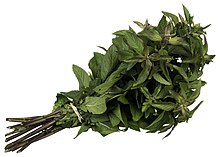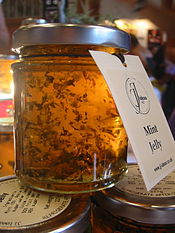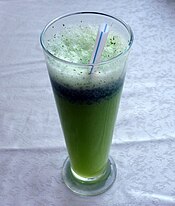Mentha
| Mentha Mint | |
|---|---|

| |
| Mentha longifolia | |
| Scientific classification | |
| Kingdom: | |
| (unranked): | |
| (unranked): | |
| (unranked): | |
| Order: | |
| Family: | |
| Tribe: | |
| Genus: | Mentha |
| Type species | |
| Mentha spicata | |
| Species | |
|
See text | |
Mentha (also known as mint, from Greek míntha,[1] Linear B mi-ta)[2] is a genus of plants in the family Lamiaceae (mint family).[3] The species are not clearly distinct and estimates of the number of species varies from 13 to 18.[4] Hybridization between some of the species occurs naturally. Many other hybrids, as well as numerous cultivars, are known in cultivation.
The genus has a subcosmopolitan distribution across Europe, Africa, Asia, Australia, and North America.[5]
Mints are aromatic, almost exclusively perennial, rarely annual, herbs. They have wide-spreading underground and overground stolons[6] and erect, square,[7] branched stems. The leaves are arranged in opposite pairs, from oblong to lanceolate, often downy, and with a serrated margin. Leaf colors range from dark green and gray-green to purple, blue, and sometimes pale yellow.[5] The flowers are white to purple and produced in false whorls called verticillasters. The corolla is two-lipped with four subequal lobes, the upper lobe usually the largest. The fruit is a nutlet, containing one to four seeds.
While the species that make up the Mentha genus are widely distributed and can be found in many environments, most grow best in wet environments and moist soils. Mints will grow 10–120 cm tall and can spread over an indeterminate area. Due to their tendency to spread unchecked, some mints are considered invasive.[8]
Species
The list below includes all of the taxa recognized as species in recent works on Mentha. No author has recognized all of them. As with all biological classifications of plants, this list can go out of date at a moment's notice. Common names are also given for species that have them. Synonyms, along with cultivars and varieties, are given in articles on the species.
|
|
Taxonomy
Mentha is a member of the tribe Mentheae in the subfamily Nepetoideae. The tribe contains about 65 genera, and relationships within it remain obscure.[3] Authors have disagreed on the circumscription of Mentha. Some authors have excluded M. cervina from the genus. M. cunninghamii has also been excluded by some authors, even in some recent treatments of the genus.[10] In 2004, a molecular phylogenetic study indicated both of these species should be included in Mentha.[4]
Selected hybrids

The mint genus has a large grouping of recognized hybrids. Synonyms, along with cultivars and varieties where available, are included within the specific species.
|
Cultivation

All mints thrive near pools of water, lakes, rivers, and cool moist spots in partial shade.[11] In general, mints tolerate a wide range of conditions, and can also be grown in full sun.
They are fast-growing, extending their reach along surfaces through a network of runners. Due to their speedy growth, one plant of each desired mint, along with a little care, will provide more than enough mint for home use. Some mint species are more invasive than others. Even with the less invasive mints, care should be taken when mixing any mint with any other plants, lest the mint take over. To control mints in an open environment, they should be planted in deep, bottomless containers sunk in the ground, or planted above ground in tubs and barrels.[11]
Some mints can be propagated by seed, but growth from seed can be an unreliable method for raising mint for two reasons: mint seeds are highly variable - one might not end up with what one presupposed was planted,[11] and some mint varieties are sterile. It is more effective to take and plant cuttings from the runners of healthy mints.
The most common and popular mints for cultivation are peppermint (Mentha × piperita), spearmint (Mentha spicata), and (more recently) apple mint (Mentha suaveolens).
Mints are supposed to make good companion plants, repelling pesty insects and attracting beneficial ones. They are susceptible to whitefly and aphids.
Harvesting of mint leaves can be done at any time. Fresh leaves should be used immediately or stored up to a few days in plastic bags in a refrigerator. Optionally, leaves can be frozen in ice cube trays. Dried mint leaves should be stored in an airtight container placed in a cool, dark, dry area.[12]
Uses
- §182.10 Spices and other natural seasonings and flavorings.
- Peppermint Mentha piperita L.
- Spearmint Mentha spicata L.
- §182.20 Essential oils, oleoresins (solvent-free), and natural extractives (including distillates).
- Menthol Mentha spp.
- Peppermint Mentha piperita L.
- Spearmint Mentha spicata L.
Culinary


The leaf, fresh or dried, is the culinary source of mint. Fresh mint is usually preferred over dried mint when storage of the mint is not a problem. The leaves have a warm, fresh, aromatic, sweet flavor with a cool aftertaste, and are used in teas, beverages, jellies, syrups, candies, and ice creams. In Middle Eastern cuisine, mint is used on lamb dishes, while in British cuisine and American cuisine, mint sauce and mint jelly are used, respectively.
Mint is a necessary ingredient in Touareg tea, a popular tea in northern African and Arab countries. Alcoholic drinks sometimes feature mint for flavor or garnish, such as the mint julep and the mojito. Crème de menthe is a mint-flavored liqueur used in drinks such as the grasshopper.
Mint essential oil and menthol are extensively used as flavorings in breath fresheners, drinks, antiseptic mouth rinses, toothpaste, chewing gum, desserts, and candies, such as mint (candy) and mint chocolate. The substances that give the mints their characteristic aromas and flavors are menthol (the main aroma of peppermint and Japanese peppermint) and pulegone (in pennyroyal and Corsican mint). The compound primarily responsible for the aroma and flavor of spearmint is L-carvone.
Mints are used as food plants by the larvae of some Lepidoptera species, including buff ermine moths.
Medicinal and cosmetic
Mint was originally used as a medicinal herb to treat stomachache and chest pains. In Rome, Pliny recommended a wreath of mint for students to wear since it was thought to "exhilarate their minds". During the Middle Ages, powdered mint leaves were used to whiten teeth.[15]
Mint leaves are commonly steeped with water to make tea used as a home remedy to help alleviate stomach pain [16][17] and as a sleeping aid.[18] Mint tea is a diuretic.[19][20] A common use is as an antipruritic, especially in insect bite treatments (often along with camphor).[citation needed] The strong, sharp flavor and scent of mint is sometimes used as a mild decongestant for illnesses such as the common cold.[21][22] Mint is also used in some shampoo products.
Menthol from mint essential oil (40–90%) is an ingredient of many cosmetics and some perfumes. Menthol and mint essential oil are also much used in medicine as a component of many drugs, and are very popular in aromatherapy. Menthol is also used in cigarettes as an additive, because it blocks out the bitter taste of tobacco and soothes the throat.
Allergic Reaction
Although it is used to treat many symptoms, mint can also cause allergic reactions to some people. Although rare, these can induce painful symptoms, including abdominal cramps and diarrhea, headaches, tingling or numbing around the mouth, nasal congestion, clogging of the sinuses, nausea, etc. It can be a reaction to salicylates[23] or linalol contained in the mint, or to some of the proteins inside the plant. It is possible to have high intolerance to one type of mint such as spearmint, yet have no reaction to other types, such as peppermint and menthol, and the symptoms may get worse over time. Because it is uncommon, the people who suffer from mint allergies can find it hard to deal with it on a daily basis. Most of the problems arise from the need to find special toothpaste or dental products, but can also be reactions to the smell of somebody consuming mint candy or gum in a public or work place. In some cases, it can be a minor disturbance, but sometimes a severe reaction; because it is potent, inhaling the mint can trigger by itself breathing problems, nausea, and dizziness, separately or all together. Depending on whether the allergy is to a protein or some other chemical inside the plant, it may or may not extend to other Lamiaceae.[24]
The American Allergy and Asthma Foundation is claimed to have tracked an increasing amount of mint allergies as with allergies in general.[25]
Insecticides
Mint oil is also used as an environmentally friendly insecticide for its ability to kill some common pests such as wasps, hornets, ants, and cockroaches.[26]
Room scent and aromatherapy
Known in Greek mythology as the herb of hospitality,[27] one of mint's first known uses in Europe was as a room deodorizer.[28] The herb was strewn across floors to cover the smell of the hard-packed soil. Stepping on the mint helped to spread its scent through the room. Today, it is more commonly used for aromatherapy through the use of essential oils.
Diseases
Etymology of "mint"

Mint descends from the Latin word mentha, which is rooted in the Greek word minthe, personified in Greek mythology as Minthe, a nymph who was transformed into a mint plant. The word itself probably derives from a now extinct pre-Greek language (see Pre-Greek substrate).[29]
Mint leaves, without a qualifier like 'peppermint' or 'apple mint', generally refers to spearmint leaves.
In Spain and Central and South America, mint is known as hierba buena (literally, "good herb"). In Lusophone countries, especially in Portugal, mint species are popularly known as hortelã. In many Indo-Aryan languages, it is called pudīna.
The taxonomic family Lamiaceae is known as the mint family. It includes many other aromatic herbs, including most of the more common cooking herbs, such as basil, rosemary, sage, oregano, and catnip.
As an English colloquial term, any small mint-flavored confectionery item can be called a mint.[30]
In common usage, other plants with fragrant leaves may be called "mint", although they are not in the mint family.
- Vietnamese mint, commonly used in Southeast Asian cuisine is Persicaria odorata in the family Polygonaceae, collectively known as smartweeds or pinkweeds.
- Mexican mint marigold is Tagetes lucida in the sunflower family (Asteraceae).
References
- ^ μίνθα. Liddell, Henry George; Scott, Robert; A Greek–English Lexicon at the Perseus Project
- ^ Palaeolexicon, Word study tool of ancient languages
- ^ a b Harley, Raymond M.; Atkins, Sandy; Budantsev, Andrey L.; Cantino, Philip D.; Conn, Barry J.; Grayer, Renée J.; Harley, Madeline M.; de Kok, Rogier P.J.; Krestovskaja, Tatyana V. (2004). "Labiatae". In Kubitzki, Klaus; Kadereit, Joachim W. (eds.). The Families and Genera of Vascular Plants. Vol. VII. Berlin; Heidelberg, Germany: Springer-Verlag. pp. 167–275. ISBN 978-3-540-40593-1.
{{cite book}}: Unknown parameter|displayauthors=ignored (|display-authors=suggested) (help) - ^ a b Bunsawat, Jiranan; Elliott, Natalina E.; Hertweck, Kate L.; Sproles, Elizabeth; Alice, Lawrence A. (2004). "Phylogenetics of Mentha (Lamiaceae): Evidence from Chloroplast DNA Sequences". Systematic Botany. 29 (4): 959–64. doi:10.1600/0363644042450973. JSTOR 25064024.
- ^ a b Brickell, Christopher; Zuk, Judith D. (1997). The American Horticultural Society: A-Z Encyclopedia of Garden Plants. New York, NY, USA: DK Publishing. p. 668. ISBN 0-7894-1943-2.
- ^ Aflatuni, Abbas; J. Uusitalo; S. Ek; A. Hohtola (January–February 2005). "Variation in the Amount of Yield and in the Extract Composition Between Conventionally Produced and Micropropagated Peppermint and Spearmint". Journal of Essential Oil Research. 17 (1): 66–70. doi:10.1080/10412905.2005.9698833. ISSN 1041-2905. Retrieved 2005-05-10.
- ^ Rose, Francis (1981). The Wild Flower Key. Frederick Warne & Co. p. 310. ISBN 0-7232-2419-6.
- ^ Brickell, Christopher; Cole, Trevor (2002). The American Horticultural Society: Encyclopedia of Plants & Flowers. New York, NY, USA: DK Publishing. p. 605. ISBN 0-7894-8993-7.
- ^ USDA GRIN: Mentha cordifolia Opiz ex Fresen.
- ^ Tucker, Arthur O.; Naczi, Robert F. C. (2007). "Mentha: An Overview of its Classification and Relationships". In Lawrence, Brian M. (ed.). Mint: The Genus Mentha. Boca Raton, FL, USA: CRC Press, Taylor and Francis Group. ISBN 978-0-8493-0779-9.[page needed]
- ^ a b c Bradley, Fern (1992). Rodale's All-new Encyclopedia of Organic Gardening. Emmaus, Pennsylvania, USA: Rodale Press. p. 390. ISBN 0-87857-999-0.
- ^ Ortiz, Elisabeth (1992). The Encyclopedia of Herbs, Spices & Flavorings. London: Dorling Kindersley. pp. 36–7. ISBN 1-56458-065-2.
- ^ GRAS FDA
- ^ [1] 21 CFR Part 182 Substances Generally Recognized as Safe
- ^ Mint Mouthwash, with quotes from Bankes' Herbal, 1525
- ^ "Mint (Mentha), also known as garden mint, spearmint and lamb mint is used for digestion as well as nausea.(The genus Mentha consists of 25 different species, which are variable, but Mentha spicata is normally used in herbal infusions)". Ageless.co.za. 2012-01-08. Retrieved 2013-07-14.
- ^ "Mentha Piperita - The Plant and Its Uses" (PDF). RMRA. Retrieved 2014-05-27.
- ^ "SleepyTime tea ingredients".
- ^ M.H. Dyer. "How To Make Mint Tea From The Plant". Livestrong.Com. Retrieved 2013-07-14.
- ^ Natalie Stein. "Is Peppermint A Diuretic?". Livestrong.Com. Retrieved 2013-07-14.
- ^ http://www.healthremediesblog.com/sinus-infection-remedies/natural-decongestant[dead link]
- ^ 19 November 2008 (2008-11-19). "Uses of Mint - Benefits - Mint Properties - Cure Stomach Aches | Home Remedies, Natural Remedy". Natural-homeremedies.org. Retrieved 2013-07-14.
{{cite web}}: CS1 maint: numeric names: authors list (link) - ^ "Special Diets For Food Allergies". My.clevelandclinic.org. Retrieved 2013-07-14.
- ^ Post a Question. "Coping with Mint allergy/sensitivity - Allergy". MedHelp. Retrieved 2013-07-14.
- ^ SEARCH (2011-07-11). "Mint Allergy-Causes, Symptoms, And Cure". ifood.tv. Retrieved 2013-07-14.
- ^ Bounds, Gwendolyn "Death by Mint Oil: Natural Pesticides", The Wall Street Journal, July 30, 2009, accessed December 6, 2010.
- ^ "Mint". Herbsociety-stu.org. Retrieved 2013-07-14.
- ^ Sharon J. Huntington. "A not-so-boring history of flooring". CSMonitor.com. Retrieved 2013-07-14.
- ^ Quattrocchi, Umberto (1947-). CRC World dictionary of plant names: Common names, Scientific Names, Eponyms, Sonyonyms, and Etymology. Vol. III M-Q. CRC Press. p. 1658.
{{cite book}}: Check date values in:|year=(help)CS1 maint: year (link) - ^ Davidson, Alan (1999). The Oxford Companion to Food. Oxford: Oxford University Press. p. 508. ISBN 0-19-211579-0.
